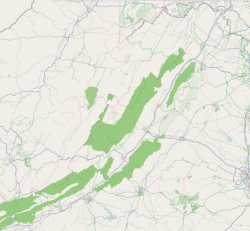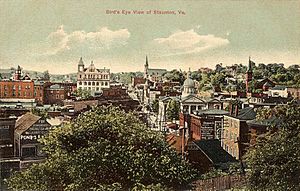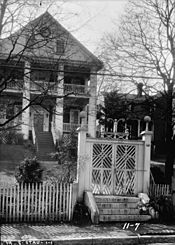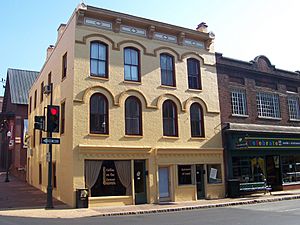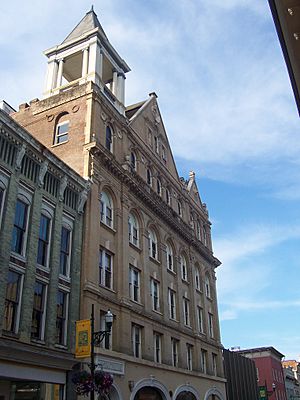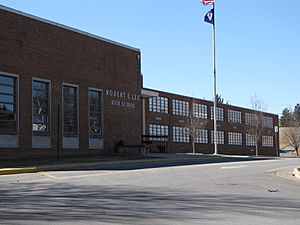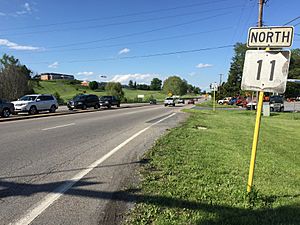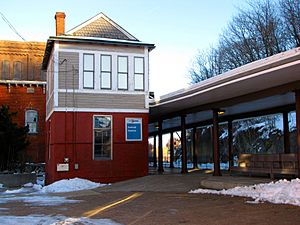Staunton, Virginia facts for kids
Quick facts for kids
Staunton, Virginia
|
|||
|---|---|---|---|
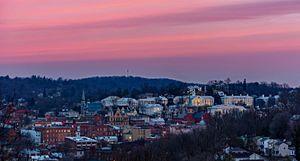
Overlook of downtown Staunton during sunrise
|
|||
|
|||
| Nickname(s):
Queen City of the Shenandoah Valley
|
|||

Location of Staunton in the Commonwealth of Virginia
|
|||
| Country | United States | ||
| State | Virginia | ||
| County | None (Independent city) | ||
| Incorporated | 1801 | ||
| Area | |||
| • Total | 19.98 sq mi (51.74 km2) | ||
| • Land | 19.92 sq mi (51.59 km2) | ||
| • Water | 0.06 sq mi (0.15 km2) | ||
| Elevation | 1,417 ft (432 m) | ||
| Population
(2020)
|
|||
| • Total | 25,750 | ||
| • Density | 1,288.8/sq mi (497.68/km2) | ||
| Time zone | UTC−5 (Eastern (EST)) | ||
| • Summer (DST) | UTC−4 (EDT) | ||
| ZIP codes |
24401-24402
|
||
| Area code(s) | 540 | ||
| FIPS code | 51-75216 | ||
| GNIS feature ID | 1500154 | ||
| Website | http://www.staunton.va.us/ | ||
Staunton ( STAN-tən) is an independent city in the U.S. Commonwealth of Virginia. As of the 2020 census, the population was 25,750. In Virginia, independent cities are separate jurisdictions from the counties that surround them, so the government offices of Augusta County are in Verona, which is contiguous to Staunton. Staunton is a principal city of the Staunton-Waynesboro Metropolitan Statistical Area, which had a 2010 population of 118,502. Staunton is known for being the birthplace of Woodrow Wilson, the 28th U.S. president, and as the home of Mary Baldwin University, historically a women's college. The city is also home to Stuart Hall, a private co-ed preparatory school, as well as the Virginia School for the Deaf and Blind. It was the first city in the United States with a fully defined city manager system.
Contents
History
The area was first settled in 1732 by John Lewis and family. In 1736, William Beverley, a wealthy planter and merchant from Essex County, was granted by the Crown over 118,000 acres (48,000 hectares) in what would become Augusta County. Surveyor Thomas Lewis in 1746 laid out the first town plat for Beverley of what was originally called Beverley's Mill Place. Founded in 1747, it was renamed in honor of Lady Rebecca Staunton, wife to Royal Lieutenant-Governor Sir William Gooch. Because the town was located at the geographical center of the colony (which then included West Virginia), Staunton served between 1738 and 1771 as regional capital for what was known as the Northwest Territory, with the westernmost courthouse in British North America prior to the Revolution. By 1760, Staunton was one of the major "remote trading centers in the backcountry" which coordinated the transportation of the vast amounts of grain and tobacco then being produced in response to the change of Britain from a net exporter of produce to an importer. Staunton thus played a crucial role in the mid 18th century expansion of the economies of the American Colonies which, in turn, contributed to the success of the American Revolution. It served as capital of Virginia in June 1781, when state legislators fled Richmond and then Charlottesville to avoid capture by the British.
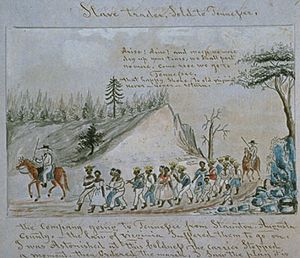
Slaves were held in Staunton. For instance, in 1815, a slave named Henry ran away from John G. Wright's Staunton plantation. Wright later placed an ad in the Daily National Intelligencer in Washington, D.C. seeking Henry's return. This ad is notable in its genre for the fact that it notes that Henry was an excellent cook and was widely travelled, having been to the West Indies.
The Civil War and immediately prior
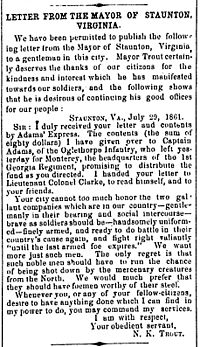
In August 1855, President Franklin Pierce visited Staunton. He gave a speech at the Virginia Hotel, in which he stated that his "feelings revolted from the idea of a dissolution of the union." He said that "[i]t would be the Iliad of innumerable woes, from the contemplation of which he shrank."
Located along the Valley Pike, Staunton developed as a trade, transportation and industrial center, particularly after the Virginia Central Railroad arrived in 1854. Factories made carriages, wagons, boots and shoes, clothing and blankets. In 1860, the Staunton Military Academy was founded. By 1860, Staunton had at least one pro-union, pro-slavery (the Staunton Spectator) and at least one pro-secession, pro-slavery newspaper (the Staunton Vindicator). The Spectator ran editorials before the war urging its citizens to vote for union, while the Vindicator ran, e.g., stories reporting on "unruly" slaves physically damaging themselves to escape being sold.
On May 23, 1861, Virginians voted on whether or not to ratify articles of secession from the Union. The articles were overwhelmingly approved throughout the Commonwealth. In Staunton the vote was 3300 in favor of secession and 6 opposed. During the Civil War, the town became an important Shenandoah Valley manufacturing, staging area and supply depot for the Confederacy. On May 2, 1862, Union General John C. Frémont occupied Staunton while on his way to a rendezvous with General Nathaniel P. Banks to pursue Stonewall Jackson into what would become known as the Battle of Cross Keys, fought near Harrisonburg, Virginia on June 6–7, 1862. By October 1862 Staunton was back in rebel hands, occupied by the 2nd South Carolina infantry.
On June 6, 1864, Union Major General David Hunter arrived with 10,000 troops to cut supply, communication and railway lines useful to the rebellion. The next day, they destroyed the railroad station, warehouses, houses, factories and mills. Union soldiers looted stores and warehouses and confiscated supplies.
Post-bellum Staunton
On July 10, 1902, Staunton became an independent city.
In 1908, Staunton created the city manager form of government. Charles E. Ashburner was hired by Staunton as the nation's first city manager.
Geography
According to the United States Census Bureau, the city has a total area of 20 square miles (52 km2), virtually all of which is land. Staunton is located in the Shenandoah Valley in between the Blue Ridge and Allegheny Mountains of the Appalachian Mountains. It is drained by Lewis Creek. Lewis Creek flows into the Shenandoah River, which flows into the Potomac, and eventually to the Chesapeake Bay.
Climate
The climate in this area is characterized by hot, humid summers and generally mild to cool winters. According to the Köppen Climate Classification system, Staunton has a humid subtropical climate, abbreviated "Cfa" on climate maps.
Demographics
| Historical population | |||
|---|---|---|---|
| Census | Pop. | %± | |
| 1860 | 3,875 | — | |
| 1870 | 5,120 | 32.1% | |
| 1880 | 6,664 | 30.2% | |
| 1890 | 6,975 | 4.7% | |
| 1900 | 7,289 | 4.5% | |
| 1910 | 10,604 | 45.5% | |
| 1920 | 10,623 | 0.2% | |
| 1930 | 11,990 | 12.9% | |
| 1940 | 13,337 | 11.2% | |
| 1950 | 19,927 | 49.4% | |
| 1960 | 22,232 | 11.6% | |
| 1970 | 24,504 | 10.2% | |
| 1980 | 21,857 | −10.8% | |
| 1990 | 24,461 | 11.9% | |
| 2000 | 23,853 | −2.5% | |
| 2010 | 23,746 | −0.4% | |
| 2020 | 25,750 | 8.4% | |
| U.S. Decennial Census 1790-1960 1900-1990 1990-2000 2010 2020 |
|||
2020 census
| Race / Ethnicity | Pop 2010 | Pop 2020 | % 2010 | % 2020 |
|---|---|---|---|---|
| White alone (NH) | 19,584 | 19,959 | 82.47% | 77.51% |
| Black or African American alone (NH) | 2,859 | 2,882 | 12.04% | 11.19% |
| Native American or Alaska Native alone (NH) | 41 | 65 | 0.17% | 0.25% |
| Asian alone (NH) | 182 | 320 | 0.77% | 1.24% |
| Pacific Islander alone (NH) | 3 | 11 | 0.01% | 0.04% |
| Some Other Race alone (NH) | 61 | 155 | 0.26% | 0.60% |
| Mixed Race/Multi-Racial (NH) | 503 | 1,270 | 2.12% | 4.93% |
| Hispanic or Latino (any race) | 513 | 1,088 | 2.16% | 4.23% |
| Total | 23,746 | 25,750 | 100.00% | 100.00% |
Note: the US Census treats Hispanic/Latino as an ethnic category. This table excludes Latinos from the racial categories and assigns them to a separate category. Hispanics/Latinos can be of any race.
Arts and culture
Staunton is home to the American Shakespeare Center, a theatrical company centered at the Blackfriars Playhouse, a replica of Shakespeare's Blackfriars Theatre. In 2012, it also became the home of the Heifetz International Music Institute, named for renowned violinist Daniel Heifetz, a summer music school and festival dedicated to the artistic growth and career development of some of the world’s most talented and promising classical musicians. The Woodrow Wilson Presidential Library is open for visitors, as well as the Museum of American Frontier Culture, which provides insight into life in early America.
Staunton is also the center of numerous galleries and art schools, including The Dwell Collective and the widely regarded Beverley Street Studio School, and its associated Co-Art Gallery. In addition Staunton is home to the Hypnagogia Film Collective, a collection of avant-garde experimental filmmakers.
Staunton is home to the Statler Brothers, country music legends who until 1994 performed free concerts at the annual Fourth of July celebration, accompanied by other country music artists. Statler Brothers members Don Reid, Harold Reid, and Phil Balsley grew up and still reside in the city. Lew DeWitt was also a notable member of the Statlers who grew up in Staunton, VA.
Folksinger Phil Ochs attended Staunton Military Academy between 1956 and 1958, where he played clarinet in the marching band. His exposure to the country music played on local radio, quite different from what he was used to hearing in his home state of Ohio, was a significant influence on his decision to become a singer.
Film
Downtown Staunton and Sherwood Avenue were used in the American Civil War film Gods and Generals. The local Shenandoah Valley Railroad as well as a number of nearby houses were used in filming of Hearts in Atlantis. In 1993, a portion of the Showtime production of Assault at West Point: The Court-Martial of Johnson Whittaker was filmed here. In the summer of 2006, some scenes for the movie Evan Almighty were also filmed in Staunton. Some scenes for Familiar Strangers were also filmed in Staunton in 2007.
Architecture
Staunton is home to nearly 200 buildings designed by architect Thomas Jasper Collins (1844–1925), who worked in various styles during the Victorian era. His firm, T. J. Collins & Sons, is still in business.
The city was once home to about ten hotels, but only one of them is still in operation - the Stonewall Jackson Hotel. This hotel was renovated in the early 2000s, and is now in operation as both a hotel and a conference center. The Ingleside Resort is also still in operation. During World War II it was used by the INS as a detention center for enemy aliens held under Executive Order 9066. Some of the hotels that are no longer in operation are The Virginia Hotel, the Eakleton Hotel, the Valley Hotel, the American Hotel and the Hotel Beverley. All of these buildings are still standing except for the Virginia Hotel, which was demolished in 1930 to make way for a planned addition to the Stonewall Jackson Hotel which was never built. The New Street Parking Garage now stands on the site. Among the houses in Staunton on the National Register of Historic Places is The Oaks, at 437 East Beverley Street. An 1840s structure, it was modified and enlarged in 1888 by famed Civil War cartographer Jedediah Hotchkiss. Also on the National Register is "Waverley Hill", a Georgian revival house designed in 1929 by renowned architect William Bottomley with a landscape designed by Arthur Shurcliff.
Shopping
Parks and recreation
- Betsy Bell Wilderness Park — a 70 acres (280,000 m2) mountaintop park with a 1,959 feet (597 m) observation platform
- Gypsy Hill Park — a 214 acres (870,000 m2) multi-use facility with a golf course, football and baseball stadiums, gymnasium, lake, two playgrounds, three youth baseball fields, public swimming pool, volleyball court, horseshoe pits, tennis courts, the Gypsy Express mini-train, the Duck Pond, a skatepark, a bandstand, and several pavilions. Until the Staunton city parks were integrated, Gypsy Hill Park was only open to whites except for one day a year, which was set aside for other races to use the park.
- Montgomery Hall Park — a 148 acres (600,000 m2) multi-use facility with softball and soccer fields, tennis courts, disc golf course, playgrounds, picnic shelters, hiking and mountain biking trails, and a swimming pool, which is nonoperational for budgetary reasons. The offices of the Department of Parks and Recreation are at the Irene Givens Administration building, which also includes a kitchen, activity room, and conference room which are available for public use. Montgomery Hall Park was opened in 1950 after much agitation by non-white residents of Staunton. Before segregation ended in the mid-1960s, Montgomery Hall park was the only park in the city open to African-Americans
- Booker T. Washington Community Center — formerly the segregated Booker T. Washington High School, although according to the court which decided Bell v. Staunton Board of Education, the term "high school" was a misnomer, as the school also contained "first, second, and seventh grade classes and two special mentally retarded classes as well as the eighth through the twelfth grades."
- Nelson Street Teen Center — closed (as of 2011[update]) due to budget cuts.
Sister cities
Vişeu de Sus, Romania.
Economy
Top employers
According to Staunton's 2015 Comprehensive Annual Financial Report, the top employers in the city are:
| # | Employer | # of Employees |
|---|---|---|
| 1 | Western State Hospital | 500-599 |
| 2 | Staunton City Schools | 500-599 |
| 3 | Mary Baldwin University | 250-499 |
| 4 | City of Staunton | 250-499 |
| 5 | Walmart | 250-499 |
| 6 | Fisher Auto Parts | 250-499 |
| 7 | Home Instead Senior Care | 100-249 |
| 8 | Cadence, Inc. | 100-300 |
| 9 | VDOT | 100-249 |
| 10 | Virginia School for the Deaf and the Blind | 100-249 |
Sports
In 1894, Staunton fielded a baseball team in the original Virginia League: The Staunton Hayseeds. In 1914, the city fielded a team in the Virginia Mountain League: The Staunton Lunatics. The Lunatics moved to Harrisonburg in July 1914, just before the league disbanded. From 1939 to 1942, the city fielded a team in the second Virginia League: the Staunton Presidents. Staunton currently has no minor league baseball, but the Staunton Braves represent the city in the Valley Baseball League, a collegiate summer baseball league that plays in the Shenandoah Valley.
Education
Staunton City Schools is the school district of the city.
Black Virginians were largely barred from education until Reconstruction. The first school in Staunton which allowed African-Americans to attend was established by the Freedmen's Bureau under the supervision of the commanding general of the occupying Union army in late 1865. Arrangements were made to bring in women from the North as teachers, and the jury rooms of the Augusta County Courthouse, located at 1 E. Johnson Street, were to be used as classrooms. The court protested this plan, however, and it is possible that another location was found.
In 1964 the Staunton chapter of the NAACP threatened the city with a lawsuit if they did not immediately desegregate the public schools. The City School Board, headed by Thomas W. Dixon, declined to take further action, contending that the schools were already desegregated as ten black children had been allowed to attend previously all-white schools. Attorneys for the city of Staunton submitted a plan for the desegregation of its public schools in 1965 by eliminating all negro schools in time for the 1967–1968 school year, which was approved by the Department of Health, Education and Welfare. However, the implementation of this plan was delayed to such an extent that a group of African-American parents brought suit in the United States District Court for the Western District of Virginia against the city. This case, Bell v. School Board of Staunton, was decided on January 5, 1966, with the court stating that the delay was a violation of the rights of the students under the Fourteenth Amendment and ordering that the schools and their faculty be desegregated in time for the 1966–1967 school year.
The Staunton city school district was one of 21 in Virginia which take elementary school students out of class for Bible lessons on a voluntary basis, a practice known as Weekday Religious Education. Although the U.S. Supreme Court ended taxpayer-funded religious education in 1948 in McCollum v. Board of Education, four years later they opened the door to privately funded voluntary classes held during school hours but away from school premises in Zorach v. Clauson. In 2005, a group of parents in Staunton asked the school board to halt the practice. The challenge was successful, and the Bible classes are no longer being taught as of April 2017.
Public
District schools:
- T.C. McSwain Elementary School
- A.R. Ware Elementary School
- Bessie Weller Elementary School
- Shelburne Middle School
- Staunton High School
- Dixon Educational Center (includes Genesis Alternative Education Program)
State-operated:
- Virginia School for the Deaf and Blind
Private
- Stuart Hall School—preparatory school (boarding for coed, day school for coed)
- Grace Christian School—Coed Christian School for Pre-K to 12th Grade
- C. F. Richards Jr. Academy—coed Seventh-Day Adventist school
- Mary Baldwin University—Private liberal arts college, formerly a women's college
- Raw Learning — democratic / free school
Infrastructure
Transportation
Roads and highways
The main highways through Staunton include U.S. Route 11, U.S. Route 11 Business, U.S. Route 250, Virginia State Route 252, Virginia State Route 254, Virginia State Route 261 and Virginia State Route 262. U.S. Route 11 and U.S. Route 250 are the most prominent roads passing directly through Staunton, with US 11 following a northeast to southwest alignment (but signed north–south), and US 250 following a northwest to southeast alignment (but signed east–west). US 11 Business follows a slower route through downtown compared to the main US 11 routing which passes just outside downtown. State Routes 252 and 254 are minor roads leading to nearby rural areas of adjacent Augusta County. State Route 261 provides a better route for trucks following US 11 and US 250 through the city. State Route 262 forms a limited access beltway around the outskirts of Staunton. Interstate 64 and Interstate 81 both pass just outside the city limits and provide the main high-speed, high-volume roads to the Staunton region.
Public transportation
Staunton is served by Amtrak's Cardinal. The train station, which is located downtown, is the closest station to the nearby cities of Harrisonburg and Lexington. The Buckingham Branch also has a small railyard.
Staunton had a municipal bus system during the 20th century, known as the Staunton Transit Service, but it was dissolved in 1989. In 1944, World War II veteran S. Melvin Johnson wrote to Truman Gibson, assistant to William H. Hastie, advisor to Secretary of War Henry L. Stimson, regarding segregated seating on the Staunton Transit Service and stating that returning African-American soldiers would not stand for such conditions. This letter was an indication of the role that African-American veterans would later play in the American civil rights movement. In 1946, after the United States Supreme Court decision Irene Morgan v. Commonwealth of Virginia, which found that Virginia's segregated seating law was unconstitutional with respect to interstate bus routes, Ethel New, a black woman from Lynch, Kentucky, was arrested for violating the law because she had purchased an intrastate ticket. New suffered a miscarriage subsequent to her arrest and sued Greyhound Lines and the arresting officer in Staunton. In September 1947, meeting in Staunton, the Virginia Supreme Court of Appeals upheld the all-white jury's verdict exonerating both the bus line and the officer.
Blue Ridge Intercity Transit Express (BRITE) provides fixed-route transit bus service in Staunton on three routes: the Downtown Trolley, West Route, and North Route. The Coordinated Area Transportation Services (CATS) operates a demand-response service throughout the Staunton area, as well as a fixed shuttle service between the downtown areas of Staunton and Waynesboro. Virginia Breeze provides intercity bus service between Blacksburg and Washington, with a stop in Staunton.
The city is adjacent to the northernmost junction of I-81 and I-64. Virginia State Route 262 forms a partial beltway around the city, and both US 250 and US 11 pass through the city.
The nearest commercial airport is Shenandoah Valley Regional Airport in Weyers Cave, Virginia.
Healthcare
- Commonwealth Center for Children and Adolescents (formerly the DeJarnette Center after eugenicist Joseph DeJarnette) psychiatric facility
- Western State Hospital (Virginia) psychiatric facility
Notable people

- Diana Adams, dancer
- Charles W. Anderson, awarded the Medal of Honor
- John Brown Baldwin, legislator
- Mary Julia Baldwin, educator
- Phil Balsley, Baritone singer for The Statler Brothers
- Thomas Bell, Businessman, University of Virginia zealot
- Randolph C. Berkeley, major general in the United States Marine Corps, awarded the Medal of Honor
- Larry Boerner, baseball pitcher
- Allen Caperton Braxton, segregationist and Staunton representative to the revanchist Virginia state constitutional convention of 1902.
- John Breckinridge, senator and attorney general
- James Brown, 1st Secretary of State of Kentucky, U.S. Senator from Louisiana, U.S. Minister to France.
- Joseph Calhoun, congressman
- William Christian, soldier and politician
- Gertrude Harris Boatwright Claytor, poet
- George M. Cochran, Virginia Supreme Court Justice
- John E. Colhoun, senator and lawyer
- Francis Collins, Director of the NIH
- Joseph DeJarnette, psychiatrist and eugenicist
- Lew DeWitt, Tenor singer for The Statler Brothers
- Joseph W. Fifer, governor of Illinois
- Dave Fultz, baseball center fielder
- Armistead C. Gordon, author, professor of English at the University of Virginia
- William Haines, film actor and interior designer
- Wade H. Haislip, four-star general
- Emmett Hanger, politician
- Kenton Harper, printer, soldier and politician
- George Moffett Harrison, judge
- Alexander Hart, major in the Confederate Army
- John N. Hendren, judge and treasurer of the Confederate States of America
- Henry W. Holt, chief justice of the Virginia Supreme Court of Appeals
- Thomas D. Howie, teacher and military officer
- Alexander Humphreys, physician
- Parry Wayne Humphreys, congressman
- Carroll Knicely, editor and publisher
- Shannon Lucas, drummer
- Sampson Mathews, soldier and politician
- Jerry Lee May, baseball catcher for the Pittsburgh Pirates and Kansas City Royals
- Samuel Augustus Merritt, delegate and judge
- James Coffield Mitchell, congressman
- Samuel Morgan, businessman, builder and manufacturer
- Ethel Moses, actress and dancer
- Eustace Mullins, white supremacist, anti-semite, conspiracy theorist, author, and publisher of Revelation Books.
- Wilton Persons, chief assistant to Dwight D. Eisenhower and superintendent of Staunton Military Academy
- Louise M. Powell, American nurse and educator who led the University of Minnesota School of Nursing, during its formative years.
- Don Reid, lead singer and songwriter for The Statler Brothers
- Harold Reid, bass singer for The Statler Brothers
- Reese Roper, lead singer for Five Iron Frenzy
- Larry Sheets, baseball outfielder and designated hitter
- John B. Stephenson, sociologist
- Alexander Hugh Holmes Stuart, congressman, secretary of the interior, and chairman of the Committee of Nine
- Jacob Swoope, politician
- Malfourd W. Trumbo, politician and judge
- A. J. Turner, teacher of music, first director of Stonewall Brigade Band
- Thomas Wilson, congressman
- Woodrow Wilson, 28th president of the United States
- Larry Woodall, baseball catcher
- Jacob Yost, congressman
See also
 In Spanish: Staunton (Virginia) para niños
In Spanish: Staunton (Virginia) para niños




